Kartoffelpuffer , for us Americans, it is kind of a blend of Hashbrowns and a Pancake
Few aromas say Gemütlichkeit quite like the scent of potatoes sizzling in a skillet. In Germany, these golden treasures are known by many names like Kartoffelpuffer or Reibekuchen, (Rye-ba-Kooken) depending on the region. Deserving many names is cool, it has survived for centuries standing the test of time.
Across the ocean, their American cousin that I grew up with would be the Hash Brown, and we had Buttermilk Pancakes. I never understood the beauty of Potato Pancakes for a long time, not sure why.
A German Tradition: Unlike in America they are not a breakfast food, but often a complete meal with some different toppings.
In Germany there a family favorite, made in big pans where children sneak the first one off the stack before it ever reaches the table.
A treat at Christmas markets, eaten warm with applesauce or sour cream, and create comfort food memories as the s now flakes fall.
A staple at local fairs and festivals, served on paper plates from sizzling food booths,
|
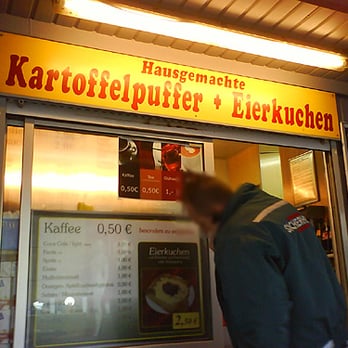 |
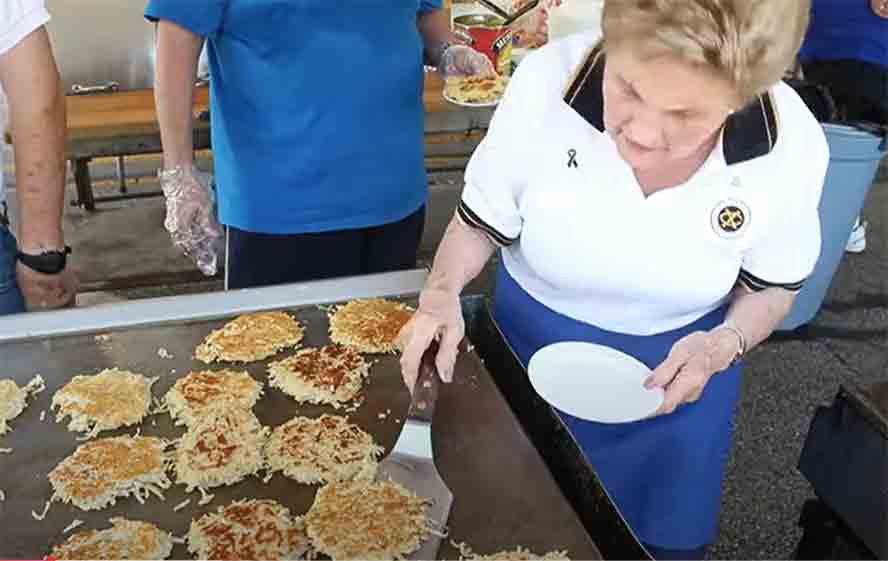
This isn’t just food—it’s memory. For German-Americans, Kartoffelpuffer link us directly to family and fun times at the markets, kitchens, and family tables of our ancestors.
At first Potatoes were NOT popular in Germany!
 |
For centuries bread was the staple in Germany.
The German lands were famous for their rye and wheat loaves, dark and hearty, sustaining families through winters and harvest years alike.
Bread wasn’t just food — it was security, culture, even a kind of currency. |
Every town had a baker, that baked your many weekly loaves of bread.
This is a picture of a cart that my grandma's family had and they would put the bread dough that was ready to be baked on and wheel it to the town baker.
Unlike in modern times homes didn't have ovens.
The baker would bake the bread and for his pay they gave him several loaves of bread. My grandma said the baker liked our bread better than most, so we got good treatment.
|
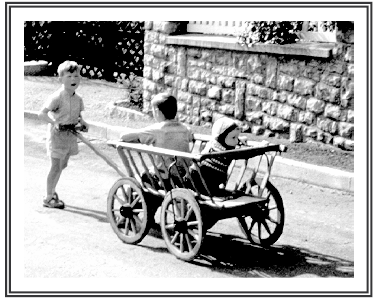 |
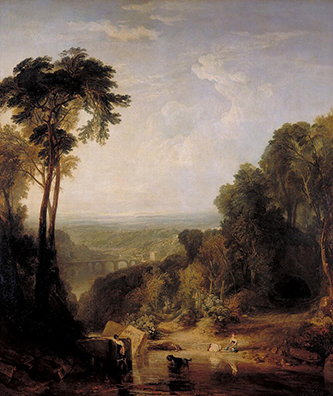
This a painting from J.W. Turner that shows the typical yellow skies of 1816 all over Europe. |
Summer of 1816
Grain Crops Failed!
in April of 1815 the eruption of Mt Tambora in Indonesia was the largest volcano in recorded history.
further eruptions of a smaller nature from the crater spewed huge amouts of ash into the air all around the world causing what is called a "Volcanic Winter" in the summer of 1816, causing temperatures to plunge.
The wheat crops failed and families were on the brink of starving. |
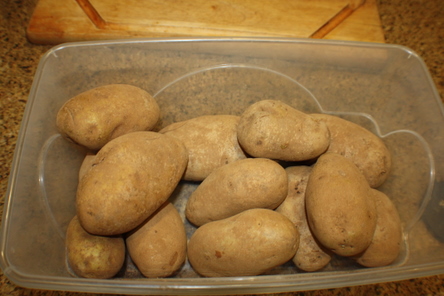
| For
The one thing that would grow well was the unpopular potato
The potato was refered to along with other tubers the generic term "Erd Apfel" back then meaning Earth Apple, did not look like the potatoes of today. The were small and not always appetizing looking or tasting.
However thanks to the urging of Fredrick the Great, who saw Germans depend on one crop too much, made a decree in the 1700's that farmers must plant potatoes.
This saved the German population later during the awful global cooling of 1816. |
At some point in time the potato got it's own name, Since they were first introduced to our Germany from Italy, they were small roundish and resembled of all things a truffle. The Italian word for truffle is Tartufalo.
Like many words, the meanings get altered over time through different accents, and Tartufalo became Kartoffel. Although in some areas Erdapfel is still used, as well as Bataten. which is where we get the English word Potato. |
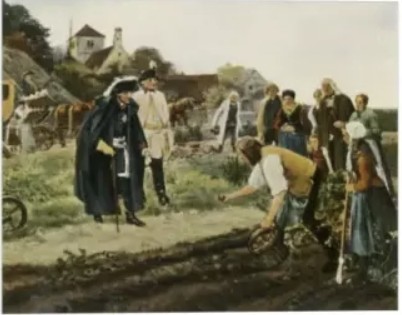
Fredrick the Great examining a potato harvest |
 |
German ingenuity helped create dishes that made the potato more tasty, like Potato Dumplings, potato salad, in soups and of course Potato Pancakes.
Also the Hausfrau that had to be frugal, created many of these dishes from leftover boiled potatoes that worked much better in dishes like the potato pancake, potato salad and as a base for dumplings.
|
A Taste of Heritage
When German immigrants came to America, they carried the tradition with them. Today, you’ll still find Kartoffelpuffer at German-American festivals, church picnics, and family reunions. Each bite dipped into applesauce is more than flavor—For me it is a connection to my heritage and memories of my fortunate
upbringing of my German family.
So next time you sit down to a plate of hash browns, pause and think of their German cousin. Better yet, try your hand at Kartoffelpuffer at home, and share them with family and friends. As our ancestors knew well, some dishes are best enjoyed together.
What are the Secrets that make German Potato Pancakes extra good!
I have often said that many German recipes blend contrasts like Yin and Yang, Sweet and Sour, creamy and crunchy, etc.
A good potato pancake often has this blend of crispy edges, a nice crust and tender potato center,
Here are a few more tips and tricks I am learning that you can adjust to your potato pancakes.
The Potato Foundation Use a mix of starchy and waxy potatoes - about 70% russets and 30% Yukon Gold. The starch creates structure while the waxy potatoes add creaminess. Grate them on the largest holes of a box grater for the perfect texture balance between crispy edges and tender centers.
The Moisture Management Secret This is where most people go wrong. After grating, salt the potatoes generously and let them sit for 10 minutes. Then comes the crucial step: wrap them in a clean kitchen towel and wring out every drop of liquid you can. The drier your potatoes, the crispier your pancakes will be. Some German grandmothers even press the wrapped potatoes under a heavy pot for extra moisture removal.
The Binding Magic Instead of just egg and flour, add a tablespoon of potato starch or cornstarch to your mixture. This creates an almost impossibly crispy exterior. The ratio should be about 2 pounds of potatoes to 1 egg and 2-3 tablespoons of flour plus that crucial tablespoon of starch.
Temperature Precision Heat your oil to exactly 350°F (175°C). Too hot and they'll burn before cooking through; too cool and they'll absorb oil and become soggy. Use a mix of neutral oil and a little butter for flavor - the butter adds richness while the oil handles the high heat.
The Pressing Technique When you add the potato mixture to the pan, press it down firmly with a spatula and don't move it for at least 3-4 minutes. This creates a golden crust that holds everything together. Flip only once, and press again on the second side.
The Resting Ritual Let the finished pancakes rest on a wire rack for 2-3 minutes before serving. This allows the steam to escape and maintains maximum crispiness. Traditional accompaniments include applesauce, sour cream, or lingonberry preserves.
The real secret is patience - don't rush the moisture removal or the cooking process. German cooks know that the best Reibekuchen, Kartoffelpuffer or whatever you call them are worth the extra time and attention to detail.
|